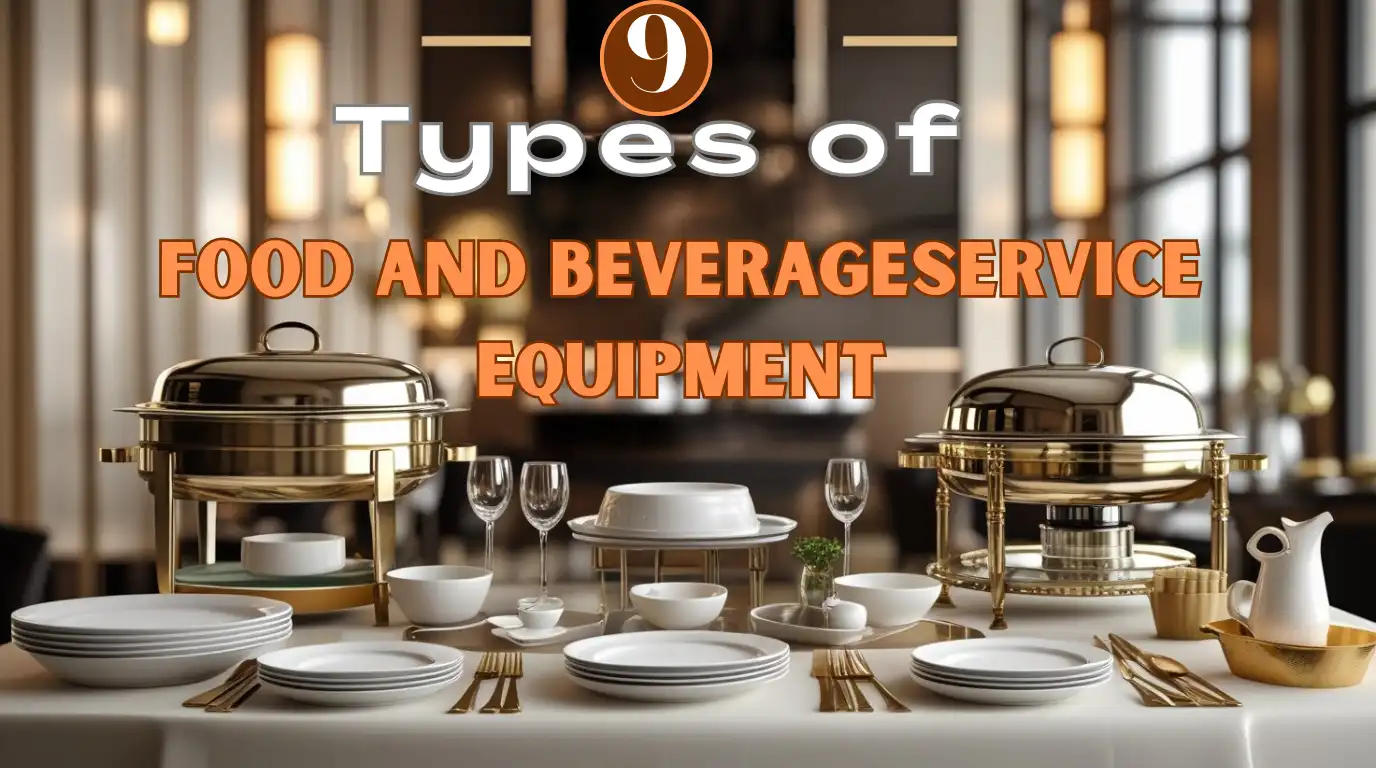Food and beverage service equipment refers to all the tools, utensils, furniture, and machinery used in the preparation, presentation, and service of food and drinks. These items are not just accessories — they are fundamental to delivering high-quality service, ensuring operational efficiency, and maintaining hygiene and safety standards.
From the elegant glassware that enhances a fine-dining experience to the hardworking trolleys used in banquet settings, every piece of equipment plays a specific role. Understanding these tools is essential for hospitality professionals, as it helps improve workflow, reduces errors, and contributes to creating memorable guest experiences.
Below is a quick visual overview of the 9 essential types of food and beverage service equipment. This infographic summarises key categories to help you understand their uses at a glance.
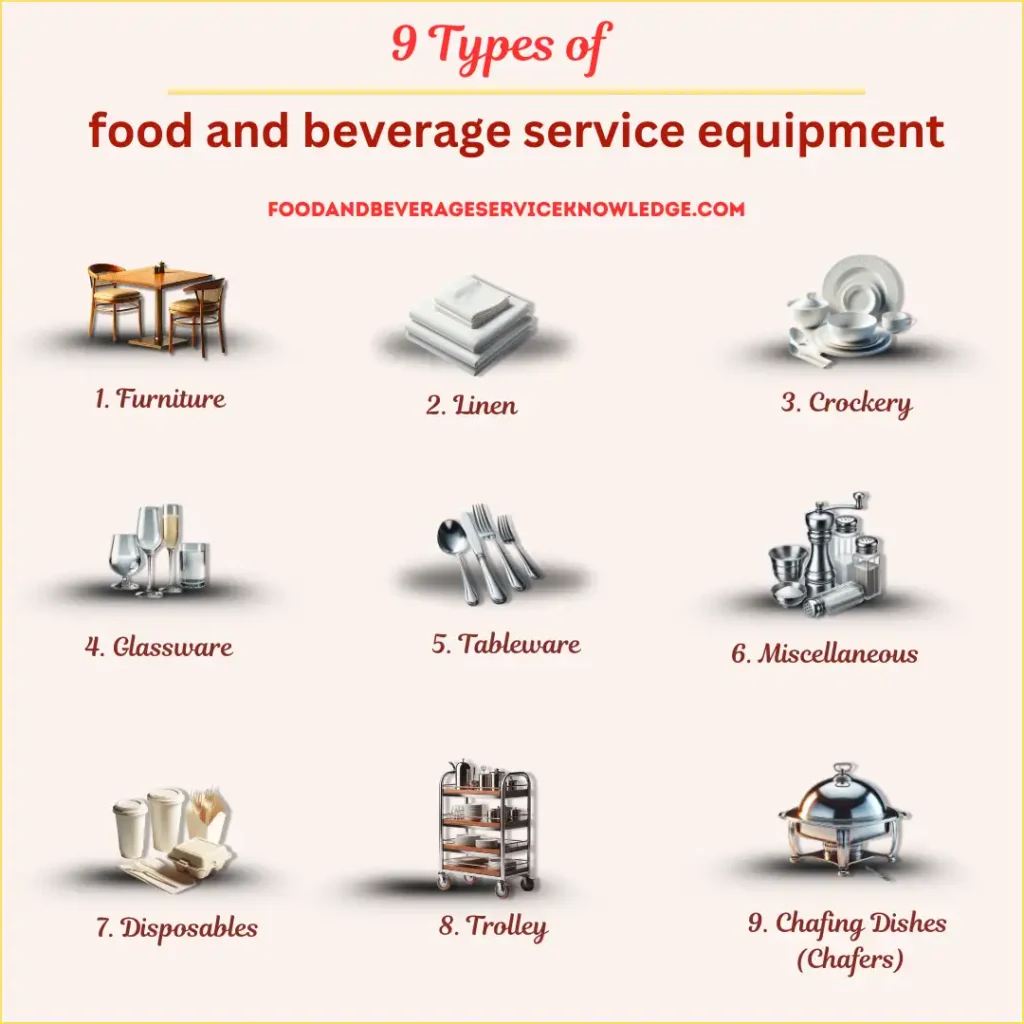
Here is a list of food and beverage service equipment
1. Furniture
In food and beverage service, furniture is not just about aesthetics; it plays a key role in operational efficiency and guest comfort. Choosing the right furniture ensures smooth service, supports the overall ambience, and provides a functional dining experience. Here are the key types of furniture used in F&B establishments:
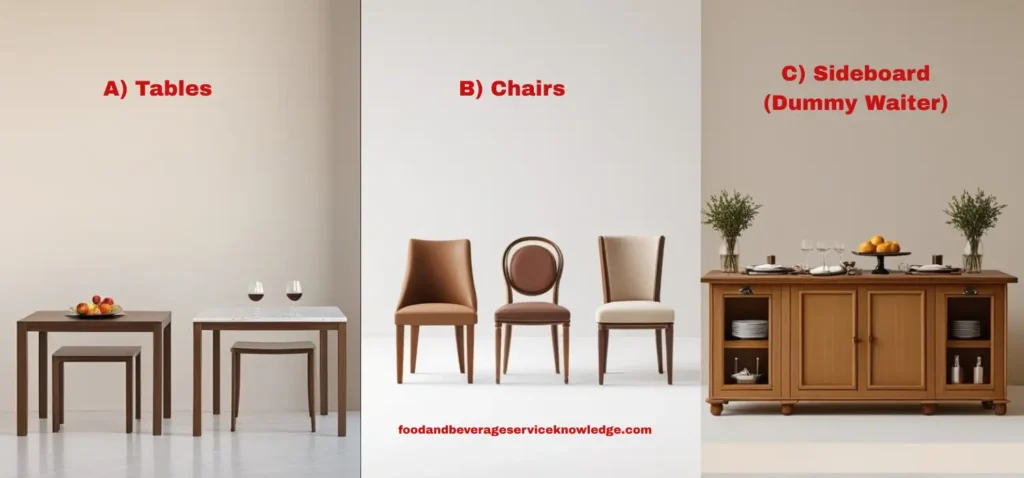
A) Tables
Tables are the centrepiece of dining setups. Their design should match the restaurant’s theme while providing practical features for service.
Types of tables used in F&B service:
1. Tabletops:
- Wooden: Preferred in upscale settings for their elegant, timeless appeal.
- Glass: Sleek and modern, offering a minimalist style but requiring more maintenance.
- Stone/Marble: Durable and luxurious, suitable for high-end environments.
- Laminate/Mica: Cost-effective and easy to clean, commonly used in casual restaurants.
2. Tablebases:
- Round bases: Provide more legroom and enhance guest comfort.
- Four-legged bases: Offer strong support but limit space under the table.
Standard Table Dimensions:
- Height: 28-30 inches (standard dining height).
- Table clearance: Ensure at least 24 inches per guest for optimal comfort.
B) Chairs
The choice of chairs impacts both comfort and the dining experience, influencing how long guests stay and their overall satisfaction.
Types of chairs used in F&B service:
- Wooden Chairs: Classic look, perfect for fine dining and traditional settings. Offers durability and a natural, warm aesthetic.
- Metal Chairs: Modern and lightweight, ideal for minimalist or industrial designs.
- Upholstered Chairs: Provide extra comfort, often used in lounges or high-end restaurants. Require more maintenance but elevate the overall dining experience.
- Banquet Chairs: Stackable, lightweight, and durable, making them practical for large events and quick setups.
- High Chairs: Adjustable and child-safe, these chairs ensure comfort and safety for younger guests.
C) Sideboard (Dummy Waiter)
A sideboard is an essential piece of service furniture used for storage and organisation during service. It helps ensure that waitstaff have immediate access to necessary tools and supplies.
Main Functions:
- Stores cutlery, crockery, glassware, napkins, and condiment sets.
- Provides a space for organising and preparing items for service.
Common Items Stored:
- Cutlery: Spoons, forks, knives.
- Crockery: Plates, cups, and saucers.
- Glassware: Water glasses, wine glasses.
- Miscellaneous: Sugar bowls, candles, and check presenters.
Wikipedia – Sideboard: Provides a detailed overview of sideboards, their history, and uses in various settings, including restaurants. Read more on Wikipedia.
D) Other Essential Furniture
- Dining Tables: Available in various sizes and shapes, depending on the restaurant’s seating arrangements. Ensure flexibility for different group sizes and occasions.
- Banquet Tables: Foldable and stackable for easy transport and setup, especially during large events or buffets.
- Service Carts/Trolleys: Used for tableside service, such as wine presentations or flambé dishes.
List of Furniture used in food and beverage service with size and uses
| Furniture Type | Size | Uses |
|---|---|---|
| Tables | Square (2 ½ x 2 ½ ft): Seats 2 persons | Ideal for small, intimate dining setups. Perfect for cafes or casual settings. |
| Square (3 ft x 3 ft): Seats 4 persons | Suitable for small groups or family dining in casual restaurants. | |
| Rectangle (4 ½ ft x 2 ½ ft): Seats 4 persons | Typically used in casual or family-style restaurants. Can also be used for business dining or private settings. | |
| Round (3 ft diameter): Seats 4 persons | Common in casual and fine dining settings. The round shape encourages conversation and interaction among guests. | |
| Round (5 ft diameter): Seats 8 persons | Used in larger restaurants or banquet halls for group dining, events, or gatherings. | |
| Chair | Standard Chair: 18 inches seat height, 36 inches overall height, 18 inches depth | Provides seating for guests in various dining environments (wood, metal, or upholstered). Common in both casual and fine dining setups. |
| Sideboard (Dummy Waiter) | Length: 4-6 feet, Height: 36-42 inches, Depth: 18-24 inches | Provides storage for cutlery, glassware, napkins, and condiments, and serves as a staging area for serving dishes. Used to support waitstaff. |
| Service Carts/Trolleys | Varies: Typically 3-5 feet in length, 36-42 inches in height | Used for transporting dishes, drinks, or for tableside service (e.g., wine service, flambé, dessert cart). |
| High Chairs | Adjustable, generally 28-32 inches in height | Used for seating children in family-friendly restaurants. Includes safety straps and adjustable height for comfort. |
Also Read: 46 Essential Bar Equipment and Tools List and Their Use
2. Linen
Linen is crucial for creating a polished, clean, and aesthetically pleasing dining environment in the food and beverage service industry. Items such as tablecloths, napkins, tray cloths, buffet cloths, and more contribute not only to the appearance of the dining area but also to ensuring guest comfort, cleanliness, and hygiene during their dining experience.
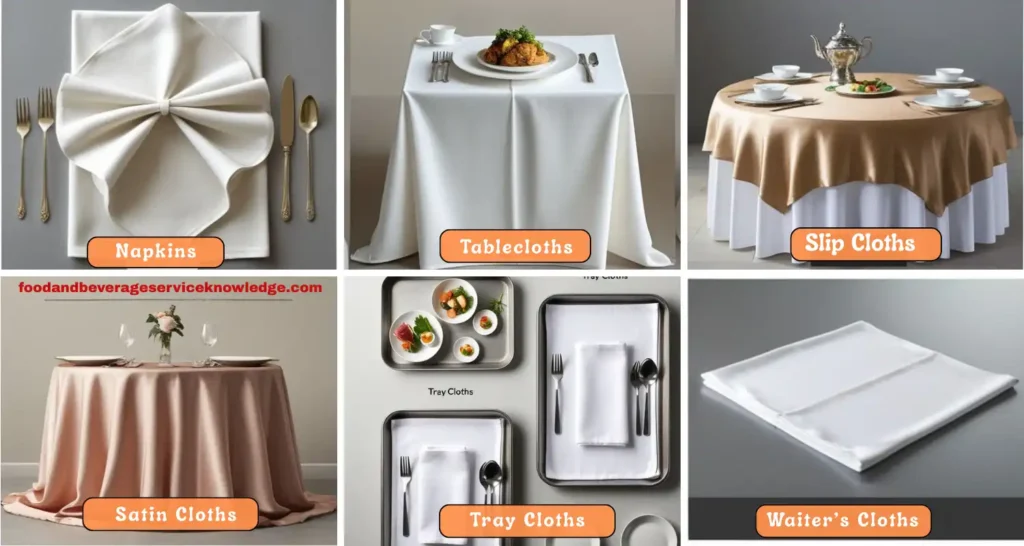
Types of Linen Used in Food & Beverage Service
- Tablecloths
- Napkins
- Slip Cloths
- Tray Cloths
- Buffet Cloths
- Satin Cloths
- Tea Cloths
Detailed Overview of Linen Types
1. Tablecloths
Tablecloths are essential for creating a formal, refined dining atmosphere. They cover the dining tables, especially wooden ones, to protect the surface while enhancing the restaurant’s decor.
Size: Tablecloths come in various sizes depending on the table dimensions. For example:
- Square Tables: 2 ½ x 2 ½ ft or 3 x 3 ft.
- Rectangular Tables: 4 ½ x 2 ½ ft.
- Round Tables: 3 ft diameter (for 4 persons) or 5 ft diameter (for 8 persons).
Key Features:
- Elevate the aesthetic appeal of the dining area.
- Protect table surfaces from spills, stains, and scratches.
- Available in various colours, patterns, and fabrics to match the restaurant’s theme.
Uses: Primarily used in fine dining and formal restaurants to enhance the ambience and protect tables. It can also be used in casual settings depending on the restaurant’s theme.
2. Napkins
Napkins are crucial for maintaining guest hygiene and comfort during their dining experience. They are placed at each cover for the guest to use throughout the meal.
Size:
- Lunch Napkins: 18 x 18 inches.
- Dinner Napkins: 20 x 20 inches.
Key Features:
- Available in various colours and fabrics to suit the restaurant’s decor.
- Ensure cleanliness and convenience by providing guests with a means to wipe hands and face.
Popular Napkin Folding Styles:
- Bishop’s Mitre
- Cock’s Comb
- Cinderella Shoe
- Cone
- Candle
- Fan
- Sail
Uses: Used by guests to wipe their hands and face. Often folded in artistic styles to enhance the table setting in upscale dining.
3. Slip Cloths
Slip cloths are thin overlays that cover the tablecloths to protect them during service or to cover soiled sections of a tablecloth. These are essential for keeping tables looking neat during busy service.
Size: Typically, slip cloths are sized to cover the table surface with a slight overhang, generally 1–2 inches beyond the table edges.
Key Features:
- Lightweight and easy to wash.
- Quick to replace during service to maintain cleanliness.
Uses: To cover existing tablecloths that are soiled or damaged, or when quick changes are needed. Often used in casual or buffet settings where frequent linen changes are required.
4. Waiter’s Cloths
Waiters’ cloths are an essential tool for servers during service. These cloths help ensure hygiene, cleanliness, and professionalism.
Size: Typically, waiters’ clothes are about 12 x 12 inches in size, small enough to fold and keep under dishes.
Key Features:
- Used to wipe the edges of plates to ensure a clean, professional presentation.
- Carried folded under plates to maintain hygiene while serving food.
Uses: Used to maintain cleanliness and hygiene when presenting food or wiping dishes during service. Essential for ensuring that dishes are presented neatly without smudges or fingerprints.
5. Tray Cloths
Tray cloths are used to line trays, preventing food and beverages from slipping while adding a professional touch to the service. They are also important for enhancing the presentation during transport.
Size: Tray cloths typically measure 12 x 12 inches to 24 x 24 inches, depending on the size of the tray.
Key Features:
- Help prevent items from slipping during transport.
- Often made of cotton or other absorbent fabrics for extra grip.
Uses: Used to line trays to prevent items from sliding off while being carried by service staff. Add to the presentation of food during transport from the kitchen to the table.
6. Buffet Cloths
Buffet cloths are used to cover buffet tables and create a neat, polished appearance. They are essential for maintaining the visual appeal and cleanliness of buffet setups.
Size: Buffet cloths come in various sizes depending on the buffet table. Typical sizes include 6 feet, 8 feet, or 10 feet in length, and they usually hang over the table edges by 12–18 inches.
Key Features:
- Help protect buffet tables from spills and stains.
- Available in different colours and materials to match the restaurant’s theme.
Uses: Used on buffet tables to maintain cleanliness and create a polished, professional look. Essential for large events, banquets, or self-service meals.
7. Satin Cloths
Satin cloths are decorative overlays used mainly in buffet setups to add a touch of elegance and luxury. These are perfect for upscale events or buffets requiring extra attention to visual appeal.
Size: Varies depending on the table size. Generally, satin cloths drape the front of the buffet table, usually measuring around 8–10 feet in length.
Key Features:
- Used primarily for decorative purposes.
- Adds a luxurious and sophisticated feel to the buffet.
Uses: Draped over the front of buffet tables to hide table legs and add elegance to the presentation.
8. Tea Cloths
Tea cloths are specifically designed for drying and wiping crockery and cutlery. These clothes are made of lint-free fabric to ensure that the finished items do not have any leftover fibres or marks.
Size: Tea cloths typically measure 18 x 24 inches or 24 x 30 inches.
Key Features:
- Made from lint-free fabric to provide a spotless, shiny finish.
- Regularly replaced to maintain hygiene standards.
Uses: Used by staff to wipe down cutlery, crockery, and glassware after cleaning to prevent watermarks and ensure a polished finish.
Also Read: Types of Food and Beverage Outlets: A Guide for Hospitality Professionals
3. Crockery
Crockery refers to all types of earthenware or chinaware used in food service, including plates, cups, saucers, pots, and vases. The material and design of crockery can greatly affect the presentation and functionality of a food and beverage service setup. Understanding the different types of crockery is essential for food service professionals, as it helps ensure the right pieces are used for the appropriate dishes and occasions.
Different Types of Crockery in Food & Beverage Service
- Earthenware
- Bone China
- Porcelain
- Stoneware
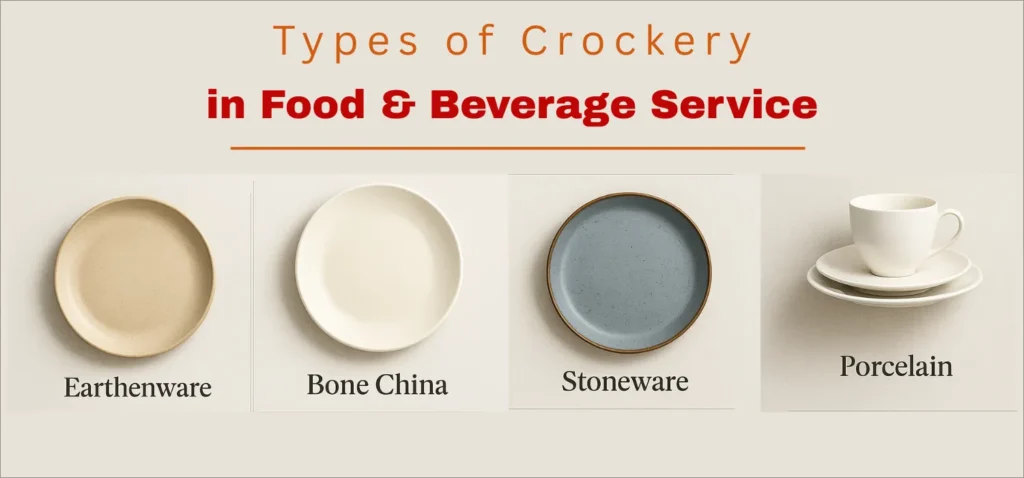
1. Earthenware
Earthenware is one of the most common types of crockery, known for being more affordable but slightly heavier and more prone to damage compared to other materials. It is made from a mixture of clay, kaolin, china stone, and flint.
Composition: 25% ball clay, 25% kaolin or clay, 15% china stone, and 35% flint.
Key Features:
- Cost: More affordable compared to other materials like bone china or porcelain.
- Durability: While durable, it is more easily chipped or cracked.
- Weight: Heavier than bone china or porcelain.
- Appearance: Often has a rustic, earthy appearance, which makes it suitable for casual dining and rustic-style restaurants.
Uses: Ideal for casual dining, cafes, and family-style restaurants. It is also used for serving mains, appetisers, and side dishes.
For more information about earthenware, visit the Wikipedia page: Earthenware.
2. Bone China
Bone China is a premium type of crockery that is made from a combination of china clay, china stone, and calcium phosphate. It is known for its strength, translucency, and aesthetic appeal.
Composition: 25% china clay, 25% china stone, and 50% calcium phosphate (derived from bones).
Key Features:
- Strength: Bone china is incredibly strong and durable, making it resistant to chipping and cracking.
- Translucency: It has a fine, translucent appearance, which gives it an elegant and luxurious look.
- Expensive: Bone china is typically more expensive than earthenware or stoneware, which makes it ideal for upscale restaurants.
Uses: Best for fine dining and high-end establishments. Often used for dinner plates, cups, saucers, and teacups, enhancing the dining experience with its delicate and refined appearance.
3. Porcelain
Porcelain is a type of ceramic made from china clay, quartz, and feldspar. It is known for its vitreous (glass-like) quality, translucent appearance, and ability to withstand high temperatures. Porcelain is frequently used in oven-to-tableware dishes.
Composition: 50% china clay, 25% quartz, and 25% feldspar.
Key Features:
- Translucent: Porcelain has a smooth, white finish with a slight gray or blue tinge.
- Durability: Highly durable and resistant to staining, scratching, and cracking.
- Heat Resistance: Suitable for oven-to-tableware dishes, as it can withstand higher temperatures.
Uses:
- Used for both functional and decorative purposes, such as serving soups, stews, and pasta dishes.
- Popular in upscale dining settings and used for oven-safe cookware and tableware.
- Ideal for hot dishes due to its heat resistance.
4. Stoneware
Stoneware is a strong and durable type of crockery, fired at high temperatures to make it resistant to damage. It is often found in brightly colored finishes and is widely used in casual dining or themed restaurants.
Composition: Made from clay mixed with various minerals and fired at high temperatures to create a tough and hard material.
Key Features:
- Durability: Stoneware is tough and long-lasting, making it perfect for high-volume food service environments.
- Weight: It is heavier than porcelain and bone china.
- Colour Options: Available in a wide range of vibrant colours, making it perfect for themed restaurants or establishments looking to add a bold statement to their service.
Uses: Ideal for casual dining, cafes, and fast-casual restaurants where durable, colourful crockery is needed. Often used for serving large portions or family-style meals like casseroles, pasta, and hearty dishes.
Common Types of Crockery in F&B Service
Crockery comes in a variety of forms, each designed to suit specific types of food and serving styles. Below is a list of common types of crockery used in food and beverage service:
| Crockery Item | Size | Uses |
|---|---|---|
| Dinner Plate | 10 inches | Used for main courses and large servings. |
| Bread and Butter Plate | 6 inches | For serving bread, butter, or small side dishes. |
| Half Plate | 7-8 inches | Used for smaller portions or appetisers. |
| Soup Plate | 8-9 inches | Wide and shallow, used for soups, stews, and pasta. |
| Salad Plate | 7-8 inches | Ideal for salads, appetisers, or small courses. |
| Dessert Plate | 7-8 inches | Slightly smaller than the dinner plate, for cakes, pastries. |
| Cup and Saucer | Cup 6-8 oz, Saucer | For serving tea, coffee, or other hot beverages. |
| Pasta Plate | 10-12 inches | Shallow, wide plate with raised edges, ideal for pasta dishes. |
| Ramekin | 2-6 oz | Small, round dish for individual servings like soufflés or dips. |
| Gravy Bowl | 6-12 oz | For serving sauces or gravies. |
| Platter | 12-18 inches | Large serving dish for presenting family-style meals. |
| Pie Dish | 8-10 inches | Used for baking and serving pies. |
| Cereal Bowl | 5-7 inches | Ideal for serving cereals, oatmeal, or soups. |
| Rice Bowl | 5 inches | Deep bowl for serving rice or small side dishes. |
| Mug | 10-16 oz | For hot beverages like coffee, tea, or hot chocolate. |
| Coffee Cup | 6-9 oz | Typically paired with a saucer, used for serving coffee. |
4. Glassware
Glassware is an essential component of food and beverage service, contributing significantly to the overall experience of dining and drinking. Whether it’s serving wine, cocktails, or water, the style, quality, and sparkle of the glassware used play a crucial role in portraying the profile of the restaurant.
Glassware isn’t just a functional tool for serving drinks; it also enhances the overall aesthetic appeal of the beverage. Different types of drinks require different glass designs to preserve the drink’s taste, aroma, and presentation.
While there are a variety of glasses available for specific drinks, it is often beneficial to opt for a limited selection of glass types that can serve multiple purposes across different beverages.
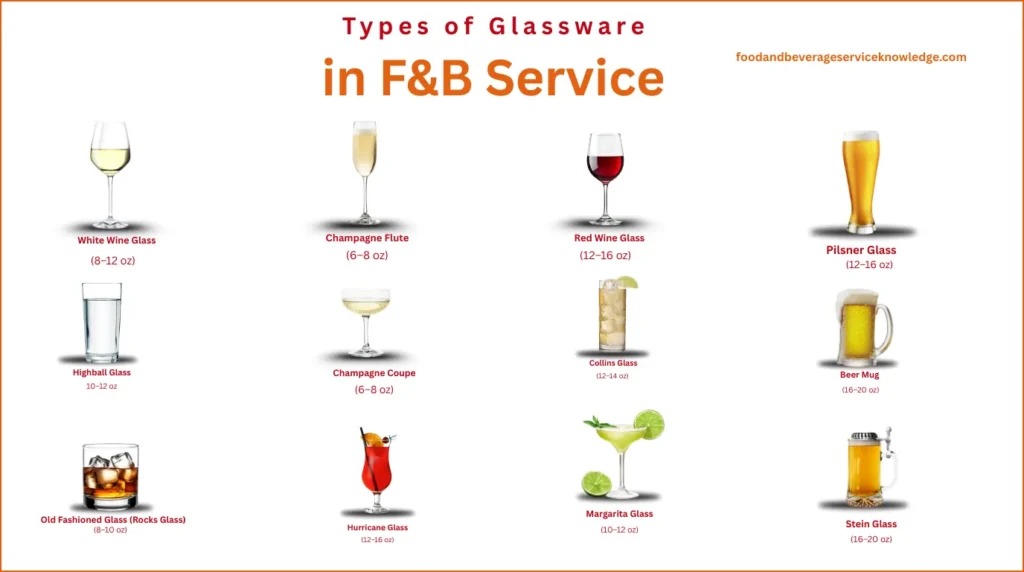
Common Types of Glassware in F&B Service
The following are the most commonly used types of glassware in food and beverage service, each designed for a specific category of drink:
| Glassware | Size | Uses |
|---|---|---|
| Water Glass | 10–12 oz | Used for serving water; typically taller and wider than other glasses. |
| Red Wine Glass | 12–16 oz | With a wider bowl to allow the wine to breathe, used for red wines. |
| White Wine Glass | 8–12 oz | Smaller with a narrower bowl to preserve the delicate aromas of white wines. |
| Champagne Flute | 6–8 oz | Tall, slender glass used for serving sparkling wines or champagne, designed to maintain the bubbles. |
| Champagne Coupe | 6–8 oz | Wide, shallow bowl; traditionally used for champagne or cocktails. |
| Martini Glass (Cocktail Glass) | 6–8 oz | Wide, stemmed glass with a conical shape for serving martinis or other cocktails. |
| Rocks Glass (Old Fashioned Glass) | 8–10 oz | Short, wide glass used for serving spirits on the rocks or cocktails like Old Fashioned. |
| Highball Glass | 8–12 oz | Tall, narrow glass for mixed drinks like gin and tonic or whiskey and soda. |
| Tom Collins Glass | 10–14 oz | Tall glasses are used for serving gin-based tall cocktails, particularly the Tom Collins. |
| Tumbler Glass | 10–12 oz | Low, wide glass used for serving whiskey, rum, or cocktails. |
| Pint Glass | 16–20 oz | Commonly used for serving beer, especially in pubs or casual dining. |
| Beer Mug | 16–20 oz | Sturdy glass with a handle, typically used for serving draft beer in pubs. |
| Irish Coffee Glass | 6–8 oz | Tall glass with a handle, used for coffee-based drinks like Irish coffee. |
| Shot Glass | 1–2 oz | Small glass used for serving spirits in small quantities, typically for shots. |
| Cordial Glass | 2–3 oz | Small, stemmed glass for serving liqueurs or dessert wines. |
| Brandy Glass (Snifter) | 8–12 oz | Short, wide-bottomed glass with a narrow opening for serving brandy or other strong spirits, allowing the aromas to concentrate. |
| Hurricane Glass | 12–16 oz | Tall, curved glass is often used for tropical cocktails, typically garnished with fruits. |
| Frosted Glass | 8–16 oz | Glass with a frosted finish, often used for margaritas, daiquiris, and other cocktails. |
5. Tableware
Tableware encompasses all the items used to set a table, serve food, and aid in dining. It plays a crucial role in presenting food elegantly and ensuring a comfortable dining experience. Tableware is generally divided into four categories: Flatware, Cutlery, Holloware, and Silverware.
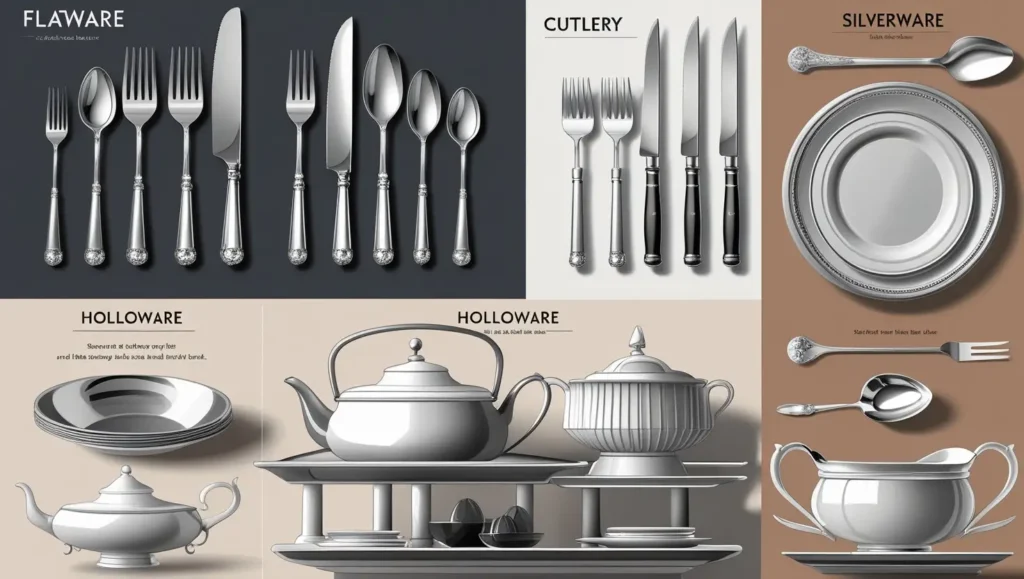
Types of Tableware
1. Flatware
Flatware encompasses the utensils used directly by individuals for eating and serving food at the table. This category includes items like forks, knives, and spoons, which are essential for daily dining. Typically made from materials such as stainless steel, plastic, or silver, flatware is designed for functionality and ease of use. It is a fundamental component of both casual and formal table settings.
Examples:
- Dinner Fork: Used for main courses.
- Soup Spoon: Designed with a rounder bowl for consuming soups.
- Butter Knife: A blunt-edged knife used for spreading butter or spreads.
2. Cutlery
Cutlery refers to hand implements used for preparing, serving, and especially eating food. While it often overlaps with flatware, cutlery also includes specialised knives used in food preparation. Materials commonly used for cutlery include stainless steel, carbon steel, and ceramic.
The term “cutlery” is more prevalent in British English, whereas “flatware” is commonly used in American English.Merriam-Webster Dictionary
Examples:
- Chef’s Knife: A versatile kitchen knife used for chopping and slicing.
- Steak Knife: A serrated knife used at the table for cutting meat.
- Paring Knife: A small knife used for intricate cutting tasks.
3. Hollowware
Hollowware comprises the hollow vessels used for serving and presenting food and beverages. Unlike flatware, hollowware items are not used for eating directly but play a crucial role in the dining experience. Common materials include metal, glass, and ceramic. These items often complement the flatware and dinnerware in style and design.
Examples:
- Teapot: Used for brewing and serving tea.
- Serving Bowl: A bowl used for presenting salads or side dishes.
- Gravy Boat: A vessel designed for serving sauces or gravies.
4. Silverware
Silverware refers to utensils and serving pieces made from sterling silver or silver-plated materials. Traditionally associated with formal dining settings, silverware adds elegance and sophistication to the table. These items require careful maintenance to preserve their lustre and prevent tarnishing. Silverware often holds sentimental value and may be passed down as family heirlooms.
Examples:
- Silver Tray: A flat, silver surface used for presenting food or drinks.
- Silver Spoon: A spoon made of silver, used for dining or serving.
- Silver Ladle: A large, deep spoon used for serving soups or stews.
List of Tableware Types and Their Uses
The following are various tableware items commonly used in the food and beverage industry, categorised by their type and function:
| Tableware Item | Size | Use |
|---|---|---|
| Flatware | ||
| Dinner Knife | 8–9 inches | Used for cutting and eating main courses like meat or vegetables. |
| Dinner Fork | 7–8 inches | Used for eating main courses, typically paired with a knife. |
| Soup Spoon | 7–8 inches | Used for consuming soups, broths, or cereals. |
| Salad Fork | 6–7 inches | Used for eating salads or side dishes. |
| Teaspoon | 5–6 inches | Used for stirring tea or coffee, or eating desserts like pudding. |
| Dessert Fork | 6–7 inches | Used for eating cakes, pies, or other desserts. |
| Butter Knife | 6 inches | Used for spreading butter on bread or rolls. |
| Cutlery | ||
| Steak Knife | 8–10 inches | Used for cutting through tough meats, especially steaks. |
| Fish Knife | 7–8 inches | Used for cutting and eating delicate fish fillets. |
| Fruit Knife | 5–6 inches | Used for cutting fruits or delicate items. |
| Dessert Knife | 7 inches | Used for eating cakes, pastries, or other desserts. |
| Holloware | ||
| Wine Chiller | Varies | Used for chilling wine or champagne at the table. |
| Teapot | 12–15 oz | Used for serving hot tea to multiple guests. |
| Coffee Pot | 20–32 oz | Used for serving coffee in formal or casual settings. |
| Serving Bowl | 8–12 inches | Used for serving large portions of food, such as salads or side dishes. |
| Gravy Boat | 10–12 inches | Used for serving gravy or sauces alongside meals. |
| Punch Bowl | 3–5 quarts | Used for serving punch or large beverages at events or parties. |
| Silverware | ||
| Silver Spoon | 6–7 inches | Used for eating soups, desserts, or stirring beverages in fine dining. |
| Silver Fork | 7–8 inches | Used for eating food during formal dining, especially main courses. |
| Silver Knife | 8–9 inches | Used for cutting and eating food during formal meals. |
| Silver Teapot | 12–15 oz | Used for serving tea in fine dining, adding elegance to the setting. |
| Silver Ice Bucket | 3–4 litres | Used for chilling bottles of wine or champagne in formal settings. |
Also Read: Sequence of Service in Restaurants: Steps of Table Service in Fine Dining
6. Miscellaneous
In food and beverage service, miscellaneous items are essential tools and accessories that support the overall dining experience but do not fall under standard categories like crockery, flatware, or glassware. These items are vital for performing specific tasks, from serving food and beverages to adding decorative touches that enhance the dining atmosphere.
While not directly involved in the actual eating or drinking process, these miscellaneous items help maintain the efficiency, presentation, and service quality within a restaurant or food service establishment.
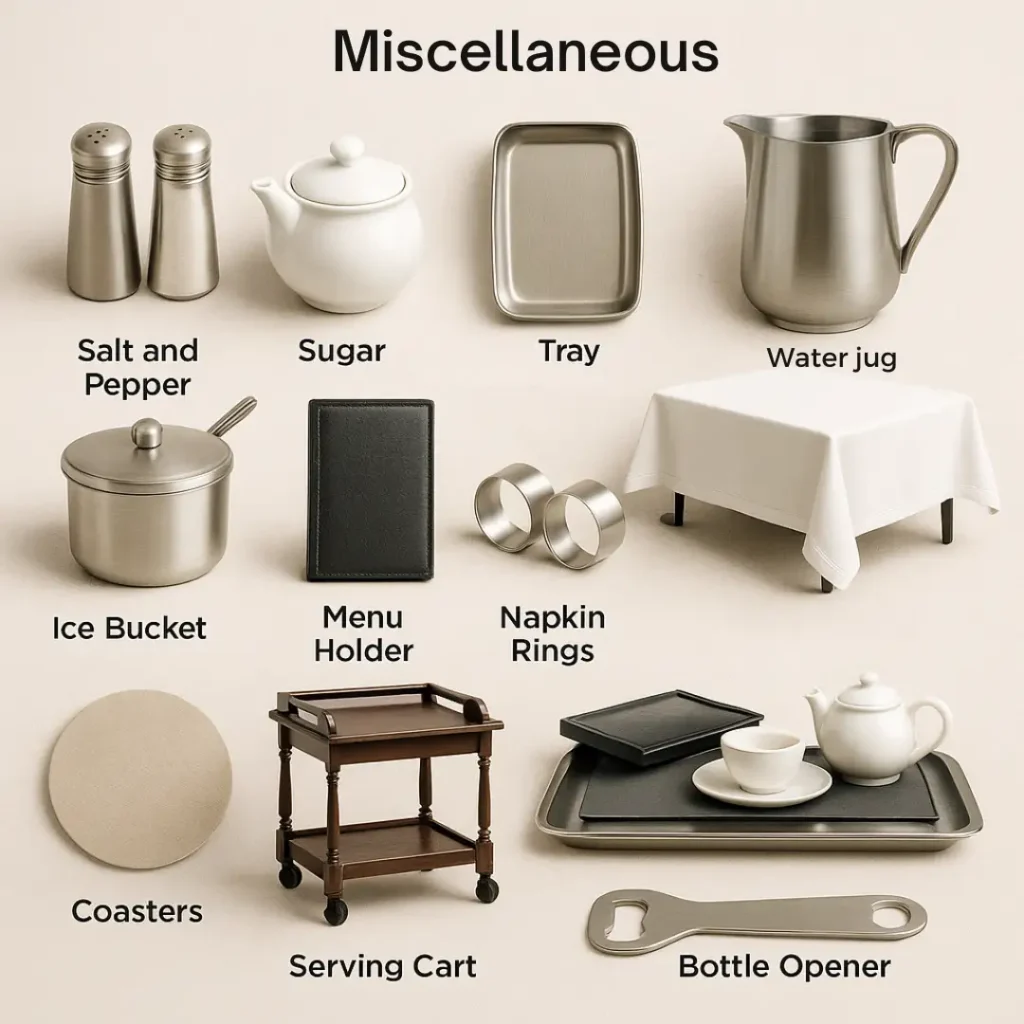
Below is a list of 11 common miscellaneous items used in food and beverage service:
| Miscellaneous Item | Size/Capacity | Use |
|---|---|---|
| Salt and Pepper Shakers | 3–5 inches tall | Used to serve salt and pepper to guests at the table. Made of glass or stainless steel. |
| Sugar Bowl | 3–4 inches in diameter | A small bowl used for serving sugar, typically accompanied by a small spoon. |
| Tray | 16×24 inches (standard) | Used for serving food and drinks. Larger trays may measure 24×36 inches for buffet-style events. |
| Water Pitcher | 32–48 oz | Used for serving water to guests, easy to refill glasses without frequent trips to the kitchen. |
| Ice Bucket | 2–4 quarts | Holds ice at the table or bar to chill beverages. May include tongs or scoops for serving. |
| Menu Holder | 8.5 x 11 inches (letter size) | A stand or folder used to display menus for guests. |
| Napkin Rings | 1.5–2 inches in diameter | Decorative items are used to hold napkins in a neat and stylish way. |
| Wine Cooler | Decorative items are used to hold napkins in a neat and stylish way. | Used to chill wine, typically made from stainless steel or silver for insulation. |
| Coasters | 4 inches in diameter (round) or 4×4 inches (square) | Placed under glasses to prevent moisture from damaging the table. |
| Serving Cart | 24×36 inches | A cart used for serving food or drinks, with multiple tiers for dishes, drinks, and condiments. |
| Bottle Opener | 3–6 inches in length | A tool used to open beer bottles and other sealed bottles. Typically made from stainless steel or wood. |
7. Disposables
Disposables refer to single-use items that are designed for convenience, hygiene, and cost-effectiveness in food and beverage service. These items are used during service and then discarded after use, making them ideal for quick-service environments, such as fast food restaurants, takeout, and buffet-style dining. Disposables are particularly useful in high-volume service settings where speed and efficiency are critical.
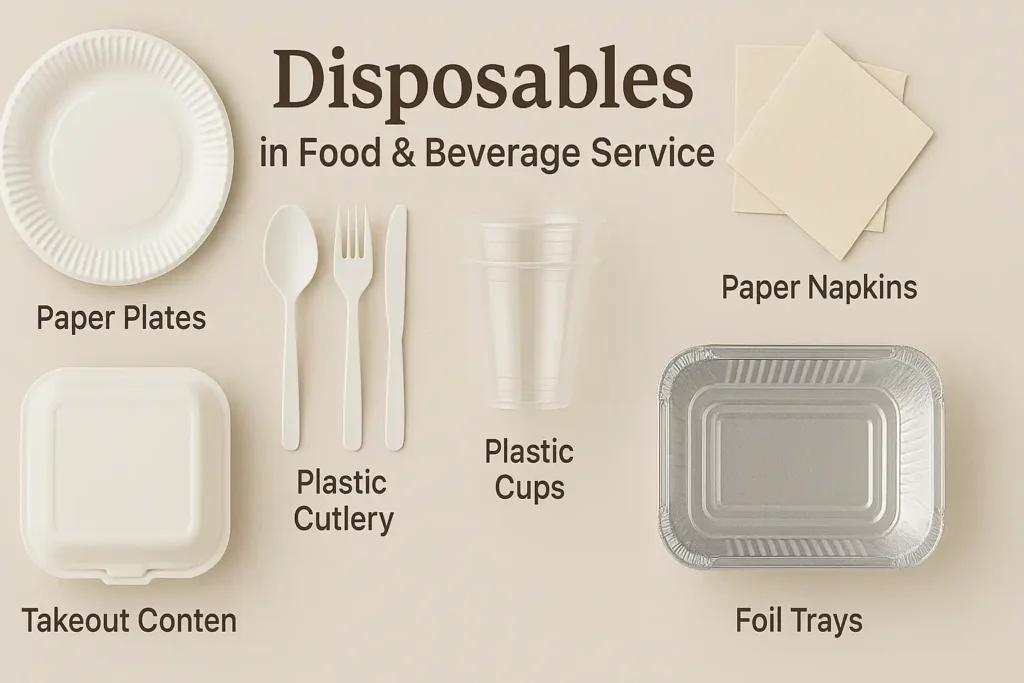
Below is a list of 6 common disposables used in food and beverage service:
1. Paper Plates
- Use: Paper plates are commonly used in casual dining, takeout, or for outdoor activities like picnics.
- Size: Available in sizes ranging from 7 to 12 inches in diameter.
- Material: Typically made of paper, sometimes with a thin coating for added strength and durability.
2. Plastic Cutlery
- Use: Plastic cutlery, including spoons, forks, and knives, is often used in fast food, takeout, or casual dining settings.
- Size: Typically around 6-8 inches in length.
- Material: Made from plastic, designed for one-time use and convenient handling.
3. Paper Napkins
- Use: Paper napkins are used for cleaning hands, wiping faces, or mopping up spills in casual dining environments.
- Size: Typically 10×10 inches or 12×12 inches when unfolded.
- Material: Made from paper, often folded into smaller sizes for easy use and storage.
4. Plastic Cups
- Use: Plastic cups are used for serving cold beverages like soft drinks, water, or iced tea in casual dining or fast food establishments.
- Size: Available in sizes such as 8 oz, 12 oz, and 16 oz.
- Material: Made from disposable plastic, often clear or colored for easy identification of the beverage.
5. Takeout Containers
- Use: Takeout containers are used for packaging food for takeout or delivery, helping keep food secure and fresh during transport.
- Size: Common sizes include 8×8 inches for small meals and 12×12 inches for larger portions.
- Material: Made from paper, plastic, or foam, depending on the type of food being packaged.
6. Foil Trays
- Use: Foil trays are often used for baking, cooking, or packaging hot food, making them especially useful for takeout, catering, or large events.
- Size: Common size is 9×13 inches for larger meals, casseroles, or party platters.
- Material: Made from aluminium foil, which helps retain heat and prevents food from sticking.
8. Trolleys in Food and Beverage Service
Trolleys are essential tools in the food and beverage service industry, offering flexibility, efficiency, and convenience in serving and storing items. These mobile units help staff move food, beverages, and other essentials around the restaurant or dining area, ensuring smooth service delivery.
One of the most notable types is the gueridon service trolley, used for tableside preparation, where dishes are cooked, flambéed, or carved directly in front of guests, adding an element of showmanship and enhancing the dining experience.
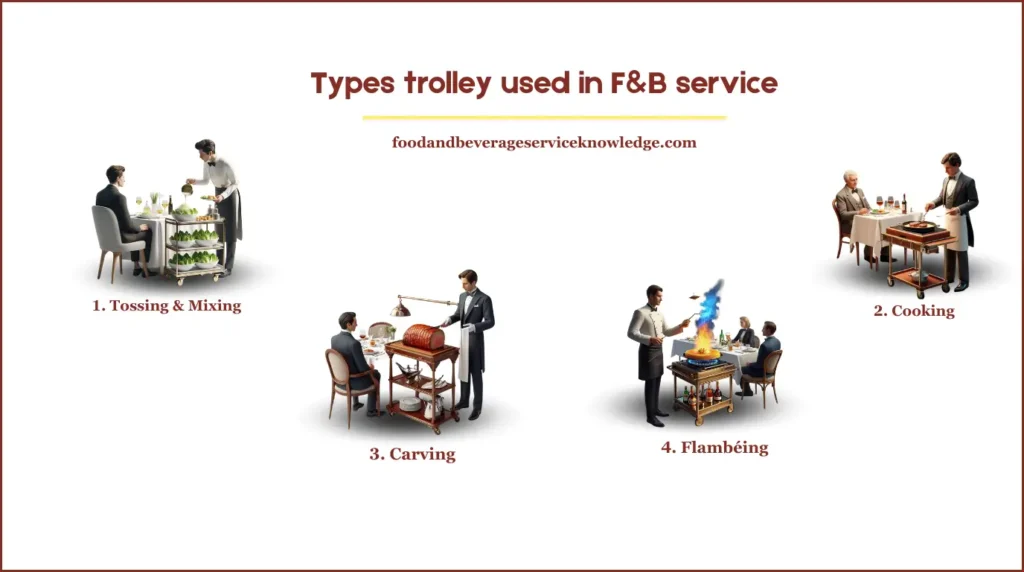
1. Hors d’Oeuvre Trolley
This trolley is used to serve appetisers or small dishes. It is typically equipped with a variety of hors d’oeuvres, allowing guests to select their preferred items directly from the trolley.
Features: Offers an elegant presentation of small bites, enhancing guest interaction and choice.
2. Salad Trolley
A mobile trolley designed for serving fresh salads, typically with an assortment of toppings and dressings that can be added at the table according to the guest’s preferences.
Features: Allows for customisation and fresh preparation of salads at the table, adding a personal touch to the dining experience.
3. Carving Trolley
Equipped with a carving station, this trolley is used for serving meats like roast beef, turkey, or lamb directly to guests, often with the server carving the meat in front of them.
Features: Provides a dramatic, interactive experience, where guests can observe the carving process and select the desired portion.
4. Flambé Trolley
This trolley features a burner and is used for flambéing dishes at the table, creating a theatrical and dramatic presentation of food preparation.
Features: Enhances the dining experience by offering a live cooking show, where dishes are prepared with flames in front of the guests.
5. Sweet Trolley
A trolley used to serve desserts typically offers a variety of sweet treats that guests can select from directly at their table.
Features: Provides an array of desserts in an attractive presentation, allowing guests to make their choice from an enticing selection.
6. Cheese Trolley
A trolley filled with a selection of cheeses is often presented in fine dining settings. Guests can choose their preferred types of cheese directly from the trolley.
Features: Offers a wide range of cheeses, providing a personalised cheese-tasting experience that complements wine or other beverages.
7. Liqueur Trolley
This trolley is used for serving after-dinner drinks, such as liqueurs, brandies, or other spirits. It is often equipped with glassware, ice, and a selection of spirits for guests to choose from.
Features: Adds sophistication to after-dinner service, allowing guests to select and enjoy drinks in a relaxed, social manner.
9. Chafing Dishes (Chafers)
Chafing dishes (chafers) are essential equipment used in food and beverage service to keep food warm over extended periods, especially during buffets, banquets, and large events. They work by placing a shallow food pan over a water pan, which is heated using a fuel source (such as Sterno cans) or electricity.
This indirect heating method maintains the food’s temperature without overcooking or drying it out, ensuring guests enjoy dishes at the proper warmth throughout service.
Chafing dishes are a staple in hotels, banquet halls, and catering operations, providing both functionality and a polished presentation.
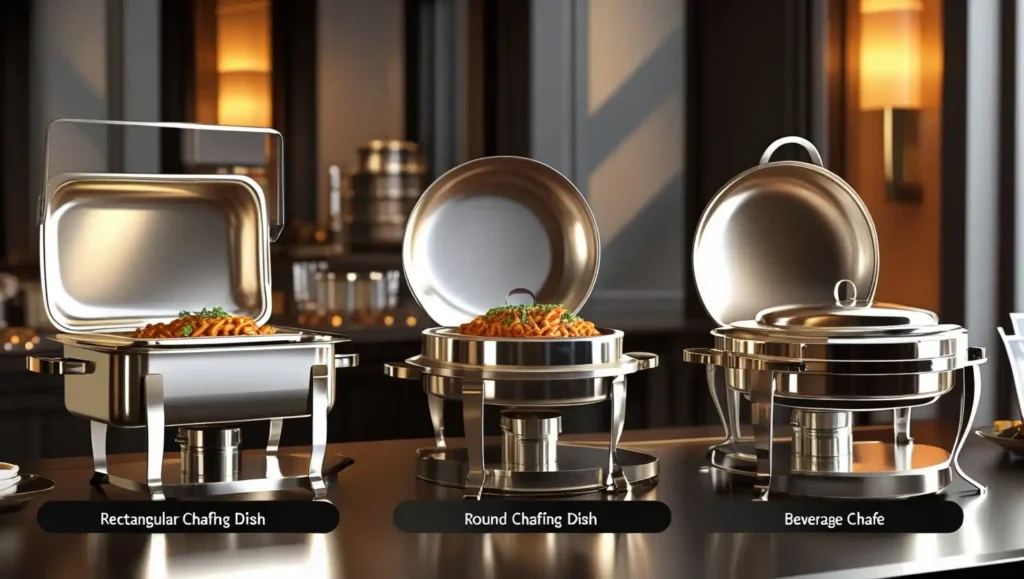
Common Types of Chafing Dishes and Their Uses
| Type of Chafing Dish | Description & Use |
|---|---|
| Standard Chafing Dish | The most common style used for buffet service, ideal for holding large quantities of main courses, rice, or vegetables. |
| Round Chafing Dish | Compact and elegant; typically used for soups, stews, or pasta dishes. |
| Square Chafing Dish | A modern, sleek option that provides a sophisticated presentation, often used in upscale or contemporary buffet settings. |
| Roll-Top Chafing Dish | Features a hinged, roll-top lid that allows easy access while minimising heat loss; perfect for formal events or high-end service. |
| Sterno Chafing Dish | Uses small Sterno fuel cans as the heat source, making it portable and well-suited for outdoor events or areas without electrical access. |
| Electric Chafing Dish | Uses electricity for consistent, adjustable heating; offers precise temperature control, suitable for indoor use where power outlets are available. |
| Half-Size Chafing Dish | A smaller version of the standard chafer, designed for limited buffet space, smaller gatherings, or serving side dishes and desserts. |
| Food Warmer Chafing Dish | Specifically designed to keep foods like soups, sauces, or curries hot; often used in combination with ladles or serving spoons for easy guest access. |
Also Read:
This article was written by Saswata Banerjee, the creator of Food and Beverage Service Knowledge, based on 8+ years of experience in the hospitality industry.

